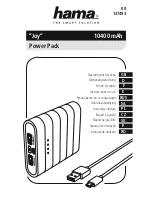
© EPS Stromversorgung in 2022, this information is subject to change without notice
41
30000800_manual_psb_10000_4u_30kw_en_04
2.3.10
Connection of the analog interface
The 15 pole connector (type: D-sub, VGA) on the rear side is an analog interface. To connect this to a controlling hardware
(PC, electronic circuit), a standard plug is necessary (not included in the scope of delivery). It’s generally advisable to switch
the device completely off before connecting or disconnecting this connector, but at least the DC terminal.
2.3.11
Connection of the Share bus
The “Share BUS” connectors on the rear side (2x BNC type) can be used to connect to the Share bus of further units. The
main purpose of the Share bus is to balance the voltage of multiple units in parallel operation, especially when using the inte-
grated function generator of the master unit. For further information about parallel operation refer to section
operation in master-slave (MS)”.
For the connection of the share bus the following must be paid attention to:
•
Connection is only permitted between compatible devices (see
“1.9.10. “Share BUS” connector”
for details)
and between a max. of 64 units
•
The Share bus of this series works in two directions, for source and sink mode. It’s compatible to a few
other device series, but it requires careful planning of the entire system, if devices are going to be connected
which solely work as sink (el. load) or as source (power supply).
2.3.12
Connection of the USB port (rear side)
In order to remotely control the device via this port, connect the device with a PC using the included USB cable and switch
the device on.
2.3.12.1 Driver installation (Windows)
On the initial connection with a PC the operating system will identify the device as new hardware and will try to install a
driver. The required driver is for a Communications Device Class (CDC) device and is usually integrated in current operating
systems such as Windows 7 or 10. But it’s strongly recommended to use and install the included driver installer (on USB
stick) to gain maximum compatibility of the device to our softwares.
2.3.12.2 Driver installation (Linux, MacOS)
We can’t provide drivers or installation instructions for these operating systems. Whether a suitable driver is available is best
carried out by searching the Internet.
2.3.12.3 Alternative drivers
In case the CDC drivers described above are not available on your system, or for some reason do not function correctly, com-
mercial suppliers can help. Search the Internet for suppliers using the keywords “cdc driver windows“ or “cdc driver linux“ or
“cdc driver macos“.
2.3.13
Initial commission
For the first start-up after installation of the device, the following procedures have to be executed:
•
Confirm that the connection cables to be used are of a satisfactory cross section!
•
Check if the factory settings of set values, safety and monitoring functions and communication are suitable for your intended
application of the device and adjust them if required, as described in the manual!
•
In case of remote control via PC, read the additional documentation for interfaces and software!
•
In case of remote control via the analog interface, read the section in this manual concerning analog interfaces!
2.3.14
Commission after a firmware update or a long period of non-use
In case of a firmware update, return of the equipment following repair or a location or configuration change, similar mea
-
sures should be taken to those of initial start up. Refer to
Only after successful checking of the device as listed may it be operated as usual.
















































